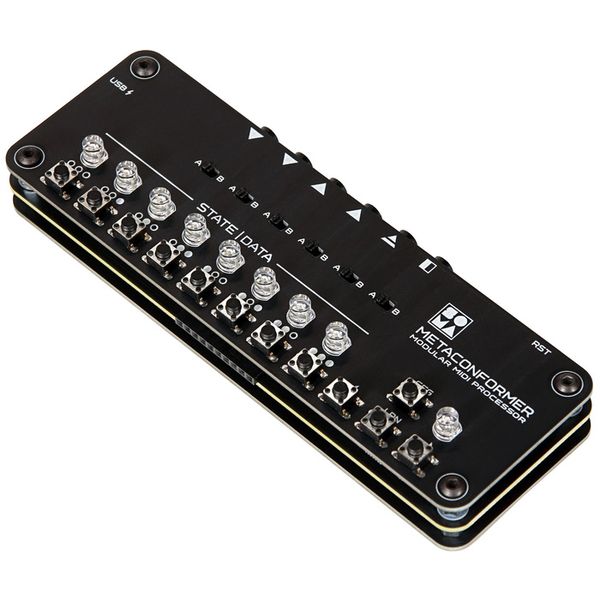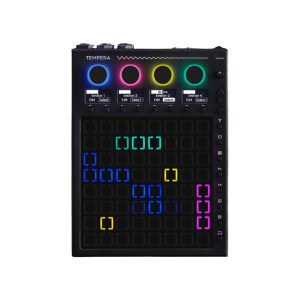MIDI is one of the most enduring technical standards in modern history; its initial implementation dates all the way back to 1983, and it’s still ubiquitous in the world of music production some 40 years later. While there have been plenty of innovative uses and custom tools built for processing and routing MIDI data over the decades (Blokas and BomeBox, respectively, have forged new ground in recent years), SOMA Laboratory’s Metaconformer takes a unique approach. It’s a customizable, modular MIDI router and thru box, designed to send MIDI data between devices in a handful of specific, creative use cases. As a standalone solution, its different functions can be configured right on the device, without the need for a computer. For those looking to get their various music machines talking to each other in new ways, it’s able to open many doors that vanilla MIDI devices aren’t capable of on their own.
In terms of the hardware, Metaconformer has two MIDI inputs and four MIDI outputs (the last of which can be conveniently configured as a sync signal source for clocking other gear). The device is surprisingly tiny—less than six inches wide, two inches tall and an inch thick—thanks in part to the fact that it uses ⅛” TRS MIDI ports for its I/O. For devices with full-size MIDI DIN ports, this does mean that you’ll need adapters; fortunately, Metaconformer is compatible with MIDI Types A and B via individual switches for each port, so either adapter type will work. (These switches effectively function as on/off switches for each device as well.) Unlike, say, SOMA’s own Pulsar-23, the device itself wasn’t designed to be super durable (it’s a series of three stacked boards with standoffs between them, which aren’t housed inside a “proper” enclosure), but the small size means it’s easy to squeeze into most desktop setups. It gets power via a standard micro-USB cable.
The MIDI inputs and outputs can essentially be configured in three modes: Splitter (splits the keyboard of one MIDI channel into several zones, where notes from each zone are sent to specific instruments, letting you play several instruments at once, without having to switch MIDI channels); Combiner (combines several monophonic instruments into one multitimbral polyphonic instrument); and Translator (notes are translated into CC messages that correspond to the specified parameter). SOMA has plans to create more modes in the future, but no details have been released for those yet.
Unlike much of SOMA’s lineup, Metaconformer isn’t a wildly experimental instrument in itself; rather, it’s a device that’s designed to extend the possibilities of existing instruments, as well as the ubiquitous MIDI standard in creative ways. The design is built around a dependable implementation of musical functions, and in practice, Metaconformer does exactly what it says on the tin; in our testing, it was unfailingly reliable in performance of its duties. Think of it as a “romantically engineered” creative utility.
The combiner mode, for instance, it allows you to combine the voices of various synths into one holistic choir of instruments: merge four monosynths into one four-voice polysynth, two four-voice synthesizers into one eight-voice polysynth, or essentially any variation thereof. Each voice can be muted individually via the buttons, letting you hear chords with different voicings and combinations of timbres. Splitter mode, meanwhile, is great for playing multiple instruments simultaneously, via the same controller; you’re able to control up to eight instruments via a single keyboard, with dedicated “note zones” for each. So if you want to control a bunch of drum sounds on a drum machine, samples from a sampler, and multiple synth voices—all via the same keyboard MIDI controller—you can do so. And importantly, you can do so without having to worry about finicky protocol issues, like having to constantly switch between MIDI channels. Once it’s set up, it makes things dead simple for the user, letting you focus on the music rather than the technical headaches that managing MIDI devices can sometimes introduce. (Interestingly, nothing will stop you from having these “note zones” overlap, creating certain note values that will thereby control multiple instruments at once; as a creative tool, this opens some interesting doors for overlapping voices, useful for synchronicity and transitions.)
The third mode, Translator, lets you control parameter changes with the keys or pads of a MIDI controller, rather than using knobs—something that would otherwise require a computer, and some combination of Max devices (or similar) to achieve. It’s great for controlling things like oscillators and filters with keys or pads, and is exceptionally fun for precisely controlling delay times—you can really dial in your values and immediately jump between them, in a way that can be difficult to achieve with standard knob or slider control. (It’s worth noting that if you want to control both sound as well as parameters via Metaconformer’s Translator Mode, they’ll need to be on separate MIDI channels. To control them simultaneously, you’ll need a dedicated keyboard for each; one MIDI channel activates the VCA envelope, while the second channel sends notes that are translated into values. Alternatively, you can accomplish this by using a second Metaconformer in Combiner mode.)
Rather than using a computer or phone app to configure the devices, or alphanumeric values on a dedicated display, all of the UI happens onboard the device via LED combinations. The approach is in the spirit of old binary computers; the upside, then, is that you can configure all of Metaconformer’s settings and manage its different modes without the need for an external device—something important if you’re working with a DAWless hardware setup. (In Play mode, you also get useful information directly via the device, such as the ability to see which individual “cells” are active or inactive.) The downside of this approach, of course, is that you’ll definitely need to RTFM, or at least have the manual handy when you want to switch up the Metaconformer’s functionality; different modes and settings are essentially represented by different combinations of LEDs. Fortunately, the manual is laid out in typically excellent and detailed SOMA fashion, along with more general setup advice offered via a series of YouTube videos. Typically, you’ll be using a particular mode in a setup, and not constantly changing between them; fortunately, the device saves your settings to memory, and functions just as you had it next time you turn it on.
As mentioned, Metaconformer has not been designed to do everything conceivable via MIDI, but rather perform a handful of dedicated tasks very well. In a moment where all the talk surrounding MIDI seems to be about MIDI 2.0 and MPE, SOMA has instead focused its energy into extending the original, ubiquitous MIDI standard into something that creatively builds upon 40 years of knowledge and interoperability, and thousands of existing devices. It’s a powerful tool that blurs the line between utility and experimentalism, breathing new life into the machines you already have.









